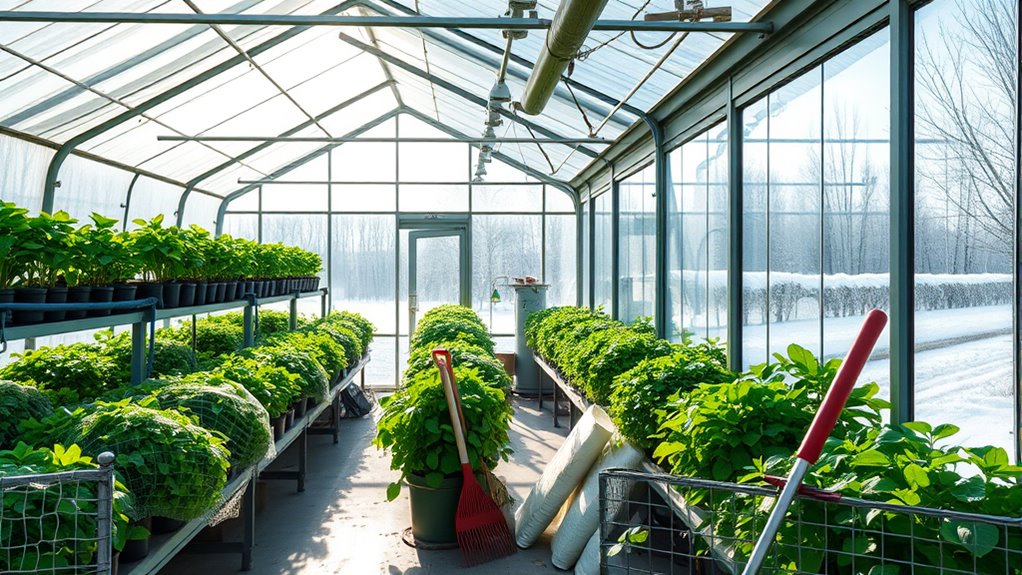To prepare your greenhouse for winter and summer, start with seasonal maintenance like soil testing and adding amendments to guarantee healthy plant growth. Inspect for structural issues such as leaks, damaged panels, or weak frames, and fix them to prevent drafts and moisture problems. Control pests proactively and keep ventilation, insulation, and humidity levels in check. Regular cleaning and proper storage also help sustain your greenhouse through seasonal extremes. Keeping up with these steps ensures your greenhouse stays healthy year-round; learn more to stay ahead.
Key Takeaways
- Conduct seasonal structural inspections to repair leaks, reinforce frames, and ensure proper insulation for temperature control.
- Test soil nutrients and pH, then amend soil to meet seasonal crop needs and prevent issues like root rot.
- Implement pest control measures by sealing gaps, removing debris, and using organic or chemical treatments as appropriate.
- Prepare for winter by sealing drafts and insulating, or for summer by ensuring adequate ventilation and shading.
- Perform routine cleaning, pruning, and proper storage of tools and supplies to maintain greenhouse health year-round.

Have you ever wondered why seasonal maintenance is essential for your home or vehicle? It’s because this routine care helps prevent costly repairs, keeps your property in top shape, and guarantees a smooth changeover between seasons. When it comes to your greenhouse, seasonal maintenance is equally critical. Proper preparation for winter and summer can make all the difference in maintaining healthy plants and a productive environment. One of the first steps you should take is soil testing. By testing your soil, you determine its nutrient content and pH levels, allowing you to amend it accordingly. This guarantees your plants have the ideal growing conditions year-round. A healthy soil foundation helps prevent issues like root rot or nutrient deficiencies, which can become more severe if ignored during seasonal changes. Additionally, soil testing can reveal the presence of pests or diseases lurking beneath the surface. Addressing these early through targeted pest control measures helps prevent infestations from spreading during the harsher months. Pest control isn’t just about treating visible pests; it involves proactive strategies to keep pests at bay before they damage your plants. During seasonal shifts, pests can become more active or seek shelter inside your greenhouse, making prevention vital. Seal any gaps, remove debris, and use organic or chemical controls as needed to keep pests from establishing themselves. Summer may bring an increase in insect activity, so staying vigilant with pest control measures can save you from losing valuable crops. Conversely, in winter, pests often seek refuge indoors, so inspecting your greenhouse regularly and implementing preventive pest control helps maintain a healthy environment. Beyond soil testing and pest control, you should also consider inspecting your greenhouse structure—checking for leaks, damaged panels, or weakened frames that could let in cold drafts or moisture. Proper ventilation and insulation are key to maintaining the right temperature and humidity levels, which are essential during extreme weather. Regular maintenance tasks such as cleaning gutters, trimming overgrown plants, and ensuring proper watering schedules also contribute to a healthy greenhouse environment. Remember, seasonal maintenance isn’t a one-time task; it’s an ongoing process that preserves the integrity of your greenhouse and the health of your plants. Incorporating proper storage techniques for tools and supplies can further extend their lifespan and effectiveness. By staying proactive with soil testing, pest control, structural checks, and storage, you’ll be well-prepared to face winter’s cold or summer’s heat, guaranteeing your greenhouse remains a productive and thriving space all year round.
Frequently Asked Questions
How Can I Prevent Pests During Seasonal Changes?
To prevent pests during seasonal changes, you should start by inspecting your greenhouse regularly. Use biological pest control methods, like introducing beneficial insects, to keep pests in check naturally. Additionally, apply natural repellents such as neem oil or garlic spray around plants to deter unwanted visitors. Ensuring good airflow and removing plant debris also helps limit pest habitats. Consistent monitoring and proactive measures keep your greenhouse healthy year-round.
What Are Eco-Friendly Methods for Greenhouse Insulation?
You’re really looking to keep the heat in without harming the environment. To do that, focus on eco-friendly methods like sustainable insulation and natural insulation materials such as straw, wool, or recycled denim. These options act as a warm blanket for your greenhouse, and they’re kind to the planet. With a little effort, you’ll have a cozy, energy-efficient space that’s both sustainable and effective—truly hitting two birds with one stone.
How Often Should I Check for Mold or Mildew?
You should check your greenhouse for mold or mildew at least once a week, especially during high humidity or warmer months. Regular inspections help with mold prevention and mildew control, preventing these issues from spreading. Look for fuzzy patches or musty odors, and address problems immediately with proper ventilation and moisture control. Consistent checks guarantee a healthy environment for your plants and keep your greenhouse in top condition.
Are There Specific Plants Needing Special Winter Care?
Think of your plants as delicate dancers needing a gentle winter waltz. Some, like tropicals, require extra winter watering and frost protection to survive the cold performance. Others, like hardy succulents, stand firm without much fuss. Know which plants need this special care, and adjust your routine accordingly. By giving them the right winter watering and frost protection, you guarantee they thrive through the cold season, ready for spring’s encore.
How Do I Ensure Proper Ventilation Year-Round?
To guarantee proper ventilation year-round, you need to focus on your ventilation systems and airflow management. Regularly check and clean vents and fans to prevent blockages. Use adjustable vents to control airflow based on weather conditions, and consider installing exhaust fans or circulation fans to improve air movement. Proper ventilation helps regulate temperature, humidity, and air quality, creating an ideal environment for your plants throughout all seasons.
Conclusion
Now that you know how to prepare your greenhouse for both winter and summer, you’re all set to keep your plants healthy year-round. Regular maintenance might seem like a chore, but isn’t it worth the effort to enjoy thriving greenery no matter the season? By staying proactive, you’ll ensure your greenhouse remains a lush, productive space. So, why not take these tips to heart and give your plants the best care possible all year long?









